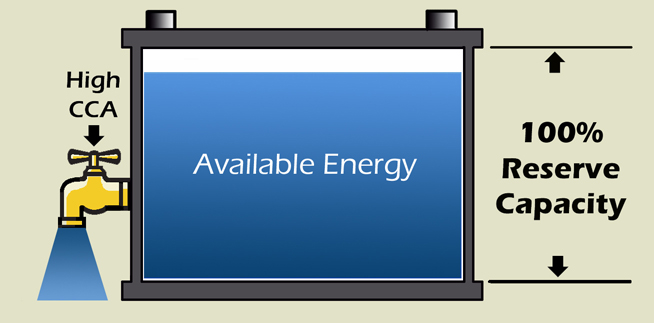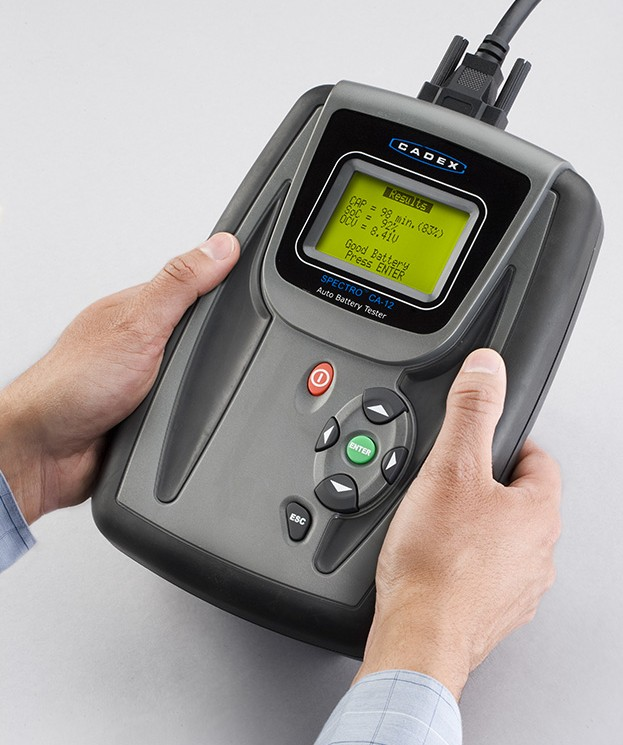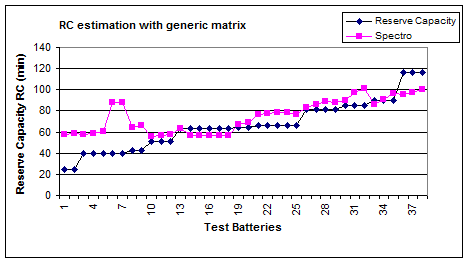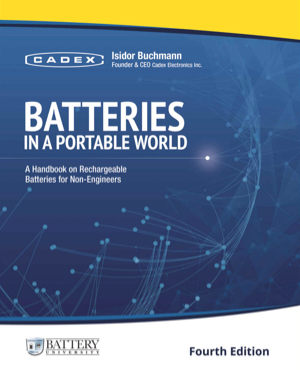AC conductance testing was introduced in 1992 as a new way of measuring the cold cranking amps (CCA) of a car battery. This non-invasive method was hailed as a major breakthrough and, to a large degree, eliminates load testing to measure battery performance. The test only takes a few seconds; the readings are displayed in digital numbers and a message spells out the condition of the battery. There are no sparks at the battery terminals and the instrument remains cool.
But single frequency AC conductance has limitations. It does not measure CCA according to SAE standards but offers an approximation relating to the battery's power output capability. This relative power figure often varies with state-of-charge and other battery conditions. At times, a good battery fails and a faulty one passes by error. But the most significant drawback is its inability to read the reserve capacity (RC). Despite these shortcomings, AC conductance has become an accepted standard for predicting battery life and determining when to replace an old battery before it becomes a nuisance.
What is the difference between CCA and RC?
A good battery needs high CCA and high capacity readings but these attributes reflect differently depending on the application. A high CCA reading assures good battery conductivity and provides strong cranking ability. High CCA goes hand-in-hand with a low internal battery resistance. Figure 1 compares high CCA with a large, open tap that allows unrestricted flow.
 | Figure 1: Battery with high CCA and 100% reserve capacity. A high CCA battery can be compared to a large, open tap that allows unrestricted flow. |
Reserve capacity governs the amount of energy the battery can store. A new battery is rated at a nominal capacity of 100%. As the battery ages, the reserve capacity drops and the battery eventually needs replacing when the reserve capacity falls below 70%. The RC reading always refers to a fully charged battery; the state-of-charge (SoC) should not affect the readings when measured with a rapid-tester.
A battery may provide a good CCA reading and start a car well but be low on reserve capacity. This battery would be run down in no time when drawing auxiliary power. Figure 2 illustrates such a battery. The so-called 'rock content' that builds up as the battery ages is permanent and cannot be reversed.
 | Figure 2: Battery with high CCA but low reserve capacity. The cranking on this battery is good but running on auxiliary power will drain the battery quickly. |
Figure 3 illustrates a battery with good reserve capacity but low CCA. This battery has a difficult task turning the starter and needs replacing even though it could be used for low load applications.
 | Figure 3: Battery with low CCA but high reserve capacity. The low CCA of this battery provides poor cranking although the reserve capacity is high. |
Capacity measurements, the most comprehensive battery test
With increased demand for auxiliary power on vehicles, measuring energy reserve is more relevant than CCA. The slogan goes: "Starting is easy… but can I steer and brake?" Modern battery testers must adapt to this new requirement and also include RC measurement. European car manufacturers place heavy emphasis on reserve capacity, while in North America CCA is still the accepted standard to assess battery performance. Most modern battery testers also provide state-of-charge readings (SoC).
Measuring reserve capacity is more complex than CCA. Many methods have been tried, including multi-frequency conductance, but most have limitations. One of the main obstacles is processing large volumes of data received when scanning a battery with multiple frequencies. Collecting the data is easy; making practical use of the information is the problem. The cost of high-speed microprocessors and processing difficulties has put the price tag on such battery testers out of range. Put changes are coming.
Cadex Electronics has developed a method that enables the processing of a large volume of data received through multi-model electro-chemical impedance spectroscopy (EIS). Trademarked Spectro™, the system injects 24 excitation frequencies ranging from 20 to 2000 Hertz. The signals are regulated at 10mV to remain within the thermal battery voltage of lead acid. This permits stable readings for small and large batteries. The test takes 20 seconds, during which about 40 million transactions are completed.
Normally, EIS requires dedicated equipment and a computer to analyze the obtained data. To permit such analyses in a hand held unit, high-speed digital signal processing is used. In 2005, the Spectro™ invention received a patent (US patent 6,778,913, Jörn Tinnemeyer).
Spectro™ has primarily been demonstrated on 12V lead-acid batteries, automotive in particular. The large pool of available car batteries provides an excellent platform to verify the technology. The same technology can also be used on nickel and lithium-based batteries.
On the strength of our invention, Cadex has developed a battery rapid-tester (CA-12) for automotive batteries. One of the strongest features of Spectro™ is its ability to reveal CCA, reserve capacity and state-of-charge on a single measurement. Displaying RC has been on the wish list of battery manufacturers and service centers for many years. In fact, this will be the first time such information can be obtained non-invasively with a commercial hand-held tester. Figure 4 shows the suggested display format.
 | Figure 4: Displays CCA, RC and SoC. During the 20-second test time, the digital signal processor completes 40 million transactions. |
The battery needs to be charged for testing. The typical test band is 50% to 100% SoC. Early tests provide stable results over a wide temperature range. There is good immunity to electrical noise. Parasitic loads of up to 30A have been tried without notable side effects. Furthermore, Spectro™ appears to be less sensitive to surface charge than single frequency AC conductance and the CCA readings are more consistent. The tester tolerates some acid stratification but chemical additives may affect the readings. Figure 5 illustrates the CA-12 tester.
 | Figure 5: Rendering of the Cadex CA-12 battery rapid-tester. The test results are available in most global standards. The RC can be shown as a percentage of the nominal capacity or in discharge time. |
Early test results on Reserve Capacity
Verifying the accuracy and repeatability of a new invention takes much time and effort. To test Spectro™, Cadex assembled a test bed of 91 car batteries with diverse performance levels. The preparation consisted of a fully saturated charge, followed by a 24-hour rest period and a 25A discharge to 10.50V (1.75V/cell), during which the reserve capacity was measured. This procedure produced an astonishing +/-15% variation in capacity readings across the full population. When comparing the capacity obtained through a conventional discharge and by non-invasive means, one must take into account the vulnerability of lead acid in producing varied readings even when using highly accurate charges and load banks.
Figure 6 compares the reserve capacities of 38 randomly chosen car batteries. The black diamonds show the reserve capacity derived through a full discharge; the purple squares represent Spectro™ estimations using a generic matrix.
 The black diamonds show the RC obtained with a full discharge; the purple squares represent Spectro™ estimations. |
How can the RC readings be further improved? Best results are achieved by sorting the batteries according to architecture and CCA rating. We developed a model specific matrix and tested a group of same-model batteries. Figure 7 shows the reserve capacity readings derived through a conventional full discharge and Spectro™. With specific matrices, the readings approach laboratory standards in terms of accuracy.
 The purple squares (Spectro™) follow the black diamonds very closely.Specific matrices approach reading within laboratory standards. |
Although the test results in Figure 6, and in particular Figure 7, look very encouraging, we need to be reminded that Spectro™ is not a universal battery tester capable of measuring any battery that comes along. It cannot be compared to a photocopier that duplicates any document or flat object by simply pressing the copy button. Rather, Spectro™ needs a battery specific matrix as a reference. To a large extent, the quality of the matrix governs the accuracy. The matrices are stored in the tester and need selecting together with the Ah and/or CCA rating. We are currently making gains in establishing generic matrices that may be used for CCA and RC measurements.
Price is another issue. Because of added complexity and higher parts count compared to single frequency AC conductance, the Spectro™ technology will command a higher price. We are not competing directly with currently available battery testers; rather, we offer a solution for those needing a better technology because the present method may be insufficient.
Summary
Technology has advanced to a point where measuring battery performance through non-invasive means will become the acceptable standard. Applying a full discharge for the purpose of obtaining the reserve capacity is impractical and stresses the battery. Multi-model electrochemical impedance spectroscopy with improved data processing algorithms will bring this task one step closer to reality.
Multi-frequencies EIS not only makes RC estimations possible; it also improves the CCA readings. Rather than providing a reference numbers relating to battery conductivity, EIS can give actual CCA equivalents. The technology also improves state-of-charge estimations. Typical applications include verifications of battery warranty returns, assessing the state-of-life of stationary batteries and checking the capacity for batteries in defense and marine applications. EIS is also an indispensable tool in examining batteries for wheelchair, golf carts, robots, boats and forklifts.

Comments
Looking for comments from the previous website?
Comments from the previous website are not compatible with our new commenting system but we have preserved them so our users can still reference and make use the information in them.
